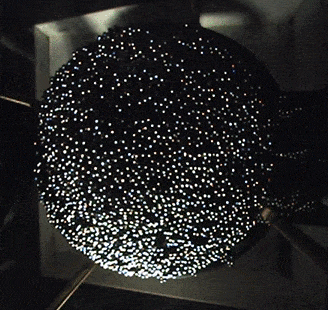My first internship at Wooster has been a highly rewarding experience. Justine and I had the privilege to work with Dr. Lehman and Dr. Jacobs on a Wooster project that has been ongoing for over two decades – The Bead Pile Experiment.
The essence of the project is the creation of a pile, using small metal beads that come from shotgun shells (yeah! pretty neat!). As additional beads are added, the pile topples. The avalanche characteristics are demonstrated when a critical point is reached or surpassed, changing in order to return to a stable point.
The bead pile models critical systems – a few examples are avalanches, forest fires, stock markets (to a certain extent), and even dynamical synapses in neural networks! By studying the pile, the conclusions will be used to discern complex critical systems in the real world.
When we commenced work, I didn’t completely understand what we were attempting to do. The thought of dropping one bead at a time to watch a pile build up and avalanche, wasn’t exactly exciting to me. Being a first year student, I was also a little anxious about being able to grasp the complexities, and make a significant contribution.
After the final Examinations, Dr. Lehman briefed us in the intricacies of the project, allowing us to gain a better understanding of the work we would be doing. It was in the third week that I truly began understanding the specifics of our model, after Dr. Jacobs went over the theory of the Bead Pile Project with us, and even gave us a few classes on Criticality!
During the course of the summer, we did a few more runs, but spent more time analyzing past data. Our focus was to recognize how changing the height the beads fall from and the stickiness of the beads changes the probability of getting avalanches of specific sizes.
With Dr. Jacobs and Dr. Lehman’s help, we installed and programmed a high-speed camera to record videos of large avalanches. This enhanced our ability to analyze the variation of trends in the graphs of the large and small avalanches. The camera is mounted above the pile (next to the bead dropper) in order to be able to see the whole pile.

We were also very keen to study how the time between certain size avalanches changed as we varied the drop height and stickiness of the beads. We also wanted to set up particle tracking with the camera to trace the path of a bead in an avalanche. However, we didn’t have enough time to do this.
In conclusion, I believe that I have gained a lot of knowledge this summer, and have thoroughly enjoyed my time working on The Bead Pile Experiment. While we learned a lot, and increased our understanding through our analysis, there is much left to be done. But isn’t that what science is all about?

Thanks, Mark! I enjoy reading your posts as well.